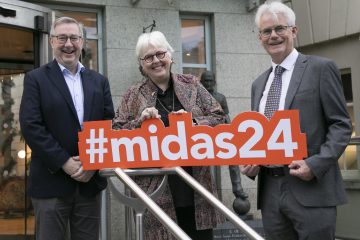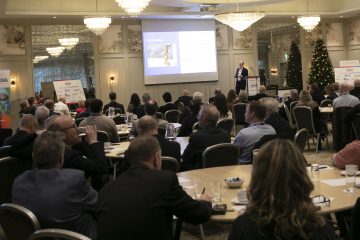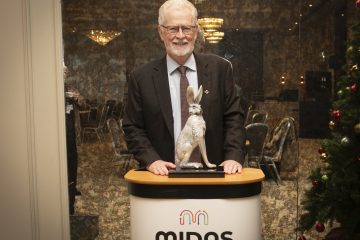Boston University and Intune Networks today announced an innovative partnership which involves the organizations coming together to create a next generation research and development network, entitled the Boston University Research Switch and Transport Network (BURST). The network will explore new network architectures, identifying how they can exploit the challenges presented by the explosion in Internet traffic and services. The BURST network is based on Irish company Intune Networks pioneering Optical Packet Switch and Transport (OPST) technology. Details of the partnership were announced at an event in Boston which was attended by the Taoiseach, (Prime Minister), of Ireland, Enda Kenny T.D.
Commenting on the Partnership Professor Alexander Sergienko from Boston University said: “With Internet video forecast to be 62 per cent of consumer Internet traffic by 2015, carriers providing consumer internet face both a challenge and an opportunity. All of this new traffic is being carried on dated networks which were not designed for this purpose. New network architectures are required to support the massive growth and on-going demand for bandwidth and performance of these new network hosted services such as video, content management & storage, applications, remote computing and social networking.
“The BURST network will seek to respond to the challenges faced by the world’s telcos – enabling a network designed for Web Services and the Cloud. We are very excited to work with Intune Networks, the developers of this disruptive technology to find solutions to this growing problem and look forward to working collaboratively to contributing to solutions in this area.”
The Irish Government has previously identified the potential that Intune’s technology presents and as a result has invested in the creation of an Exemplar Network in Ireland. This is being used as a test bed by both academic researchers and commercial organizations and is acting as a catalyst to support Ireland’s ambition to become a hub for R&D activity in the digital economy.
The BURST initiative was warmly welcomed by An Taoiseach Enda Kenny in Boston today. “ The Exemplar Smart Communications Programme which we established in Ireland has provided a state of the art platform for forward thinking service providers, telcos and research institutions to work individually or with other organisations to develop new and internationally marketable competencies. The creation of the Irish Exemplar is a key component of our initiative to position Ireland as a Knowledge Economy and at the centre of the Internet revolution, and we are already seeing the returns of the investment in this innovative Irish based technology.
We see the establishment of a similar network here in Boston as a very positive step in strengthening technology and collaborative links between both countries and taken together will cement our joint commitment to stimulating the digital economy. We all know of the wave of export of Irish citizens over the past generations to the United States, and to Boston in particular, and as an Irish citizen I am delighted to be here to acknowledge the export of such a far-reaching innovation and one which symbolises Ireland’s position in stimulating the knowledge economy worldwide.”
According to Boston based Jim Lowrie, Senior Vice President of Worldwide Sales, Intune Networks, the creation of the BURST network is a strategic initiative that supports Intune’s plans for the US this year: “As we respond to the growing need to address the challenges caused by Internet usage trends we are delighted to have a strategic partnership in place with Boston University. We are rolling out commercial trials in the US this year. To support these trials, it will be very useful for our customers to be able to see the potential of the technology in action on the BURST network. By showcasing what can be achieved in the Boston metro area organizations will get some insight into the potential of our tuning laser technology. Following an extensive period of development and research we are on the cusp of allowing commercial and research organizations benefit from our technology. It is a very exciting phase in Intune’s history.”
Intune Networks, an Irish company with offices in Dublin, Belfast and Boston, has developed a solution that can address the challenges created through increased video and other content on the Internet. The technology provides carriers with next generation networking platform which utilizes fast tuning lasers to switch and transport packets of data simultaneously delivering a guaranteed quality of experience. OPST is the world’s first commercial realization of Optical Packet Switching. By switching packets optically, and allocating bandwidth dynamically on demand, OPST is able to reduce the complexity and cost carriers will incur in building out networks to support the rising bandwidth demand and performance requirements of fast emerging services. Furthermore, this architecture aims also to facilitate the introduction of new “network centric” services which combine both network resources (bandwidth) and IT resources (content storage and computing) provided by the network operator, enabling whole network virtualization for data center applications.
The BURST Network will facilitate the research and development for the next generation of ICT (Information & Communications Technology) and services based on OPST. The BU Photonics Center BURST program will provide R&D Network partners with the capability to take their services, applications, products and operational processes and test them on an operational network under real life scenarios and conditions. Concluding Professor Alexander Sergienko from the Boston University Photonics Centre stated, “The Network will ultimately be capable of tying together major technology centres, business parks and Universities in the Boston metro area providing services to corporate and academic research groups. The basis for this Network would be to develop a metro-regional network architecture based on Optical Packet Switch and Transport technology that will be able to offer high scalability, survivability and cost efficiency for future services demands. The proposed architecture promises a green approach to information transfer through lower resource consumption, ultimately delivering greater cost efficiency for future traffic volumes and improved quality of experience compared to current metro network architectures.“


